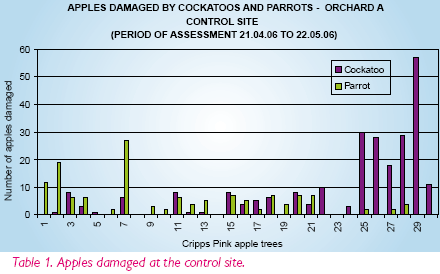

|
|
|

|
|
|
Home Bird Control Products Bird Control Solutions - Vineyards - Orchards - Marine and boats - Mining bird control - Starlings - Crows in cherries - Baudin's cockatoos - Buildings - Grain Storage - Aircraft and airports - Pine plantations - Flying foxes - Landfill - Alternative solutions Articles Reports Info Request FAQ About Us Contact Us Links |
A BirdDeter system, using radar
detection was chosen for the "Black
Cocky—Awareness & Threat Abatement
trial" to repel the targeted bird species.
As the project was only funded for
Baudin’s White-Tailed Black Cockatoo,
the BirdDeter system was set up
primarily for this species (from the
orchardist’s perspective, parrot species
also have to be considered).
The test site was 250 acres of
mixed fruit: apples, pears and plums,
with apples dominant. Two areas of
approximately 20 acres each were
chosen as the trial and control sites;
both contained Fuji and Pink Lady™
apples, which appear to be favoured
varieties of the targeted bird species.
An orchard plan was sent to Vigilance
Technologies in Queensland to
design the best layout for their equipment
to be used in the trial site.
The BirdDeter System was
installed and commenced working on
1 February and turned off at the end
of the fruit season 1 June, 2006.
Field observations — ‘truthing’
Two people were positioned diagonally
on the edge of the orchard so
they could see around all sides. They
recorded bird numbers for cockatoos
and parrots, their direction of flight,
time of movement, activation of the
BirdDeter System and the birds’ reaction
to the deterrent equipment.
This ground ‘truthing’ of the
BirdDeter radar system was carried
out over three days during one-hour
sessions. The logged data from the
BirdDeter system was compared to
the ground truthing observations and
was found to be within the recording
accuracy of the observers.
The field observations indicated
that the Baudins Cockatoo were
flying around the orchard, potentially
showing that the birds were becoming
trained to avoid the area.
Tree selection for assessment
Thirty Cripps Pink trees were
randomly selected in the trial and
control sites.
Each tree was assessed three
times at two-week intervals where
the number of apples damaged by
cockatoos and parrots was recorded.
Apples damaged by other
unknown/unrecognisable means
were counted separately and have
been included as ‘unknown’ (Table
3). Apples that were found undamaged
lying on the ground were not
counted because it was impossible to
establish what caused them to fall e.g.
bird, tractor, wind, etc.
Results
Yields in the control site went from
78 bins last year to 156 bins this
year. In the site protected by BirdDeter,
Pink Lady apple yields went from
8 bins last year to 128 bins this year.
Graphs of measured apple damage
are shown in the tables below. In Table 3
the status of apples has been separated
into four categories: cockatoo,
parrot, unknown and undamaged.

Discussion The yield of Pink Lady apples in the area protected by the BirdDeter system increased by a factor of 14 this year over last year. Such a large increase in yield could not be accounted for by yield doubling at the control site, or the age of the trees. The results show that the BirdDeter system was the major factor in achieving the yield increase. Parrots had already been feeding in the trial site orchard before the BirdDeter System was installed; there may have been less damage caused by parrots if the system was working before they had established a feeding habit. A Benefit Cost Analysis is currently being carried out.
The Warren Catchments Council ran a project, Black Cocky—Awareness & Threat Abatement in Southern Forests WA during the 2005–06 apples season. The project was sponsored by the Threatened Species Network Community Grants, CALM, WA Fruit Growers Association and equipment suppliers/ manufactures. As part of this project a bird repelling system was installed in an orchard south west of Manjimup, WA. This article is a report summary. The full report can be obtained from Lee Fontanini, Project Officer, Southern Forest Landcare, Warren Catchments Council, 52 Bath Street, Manjimup WA 6258.
|